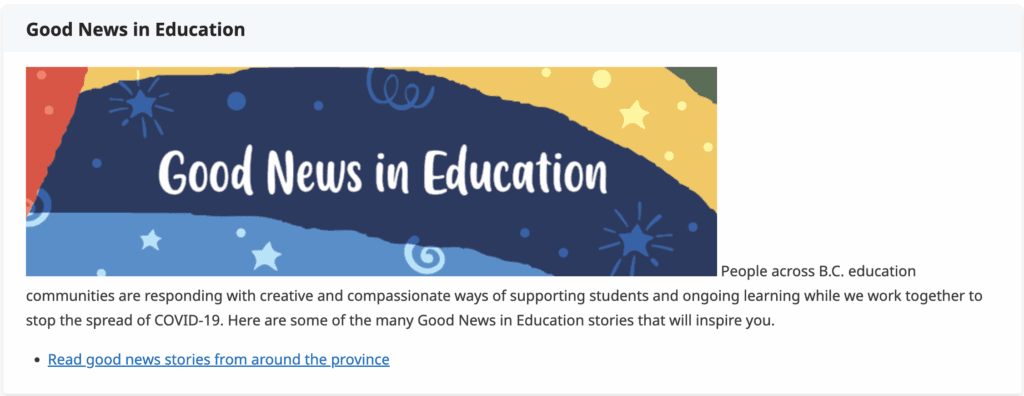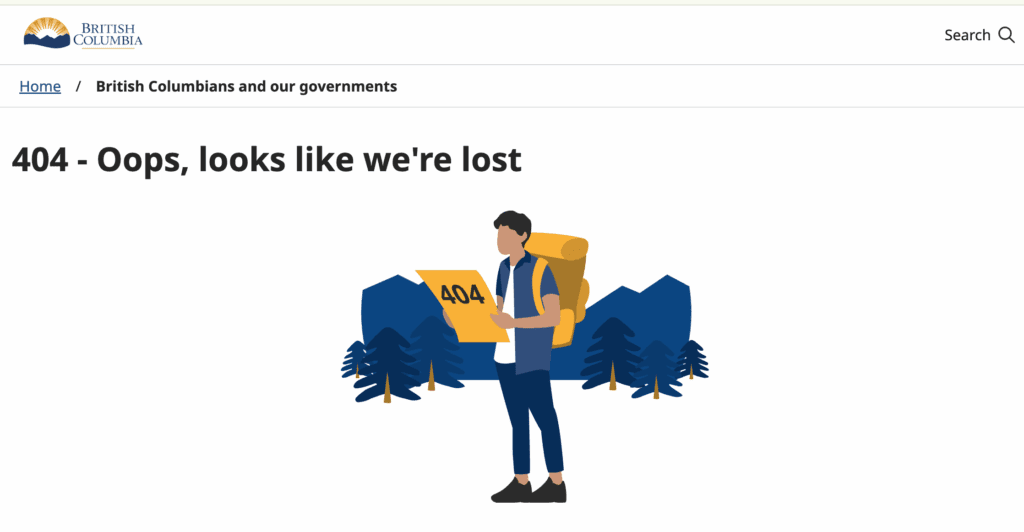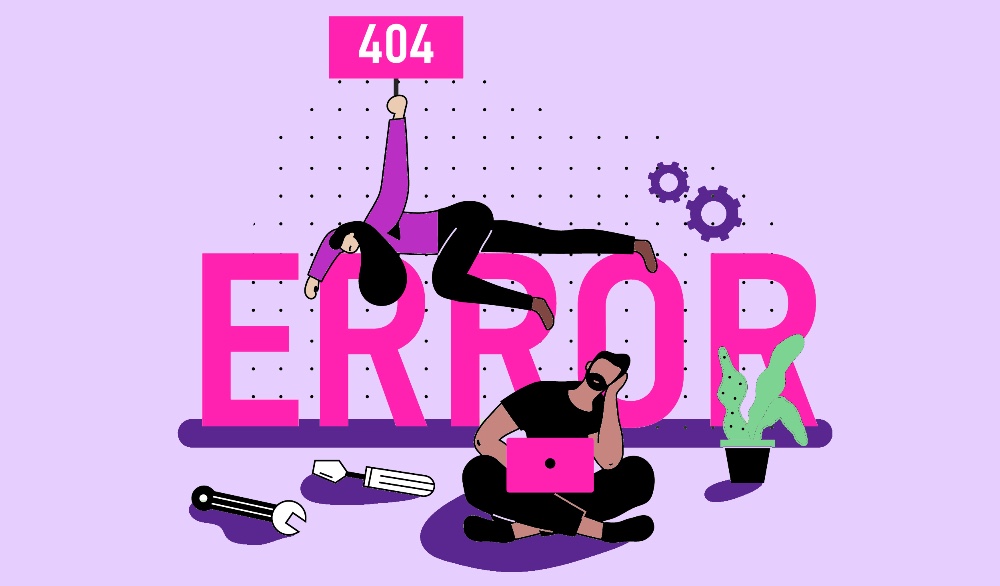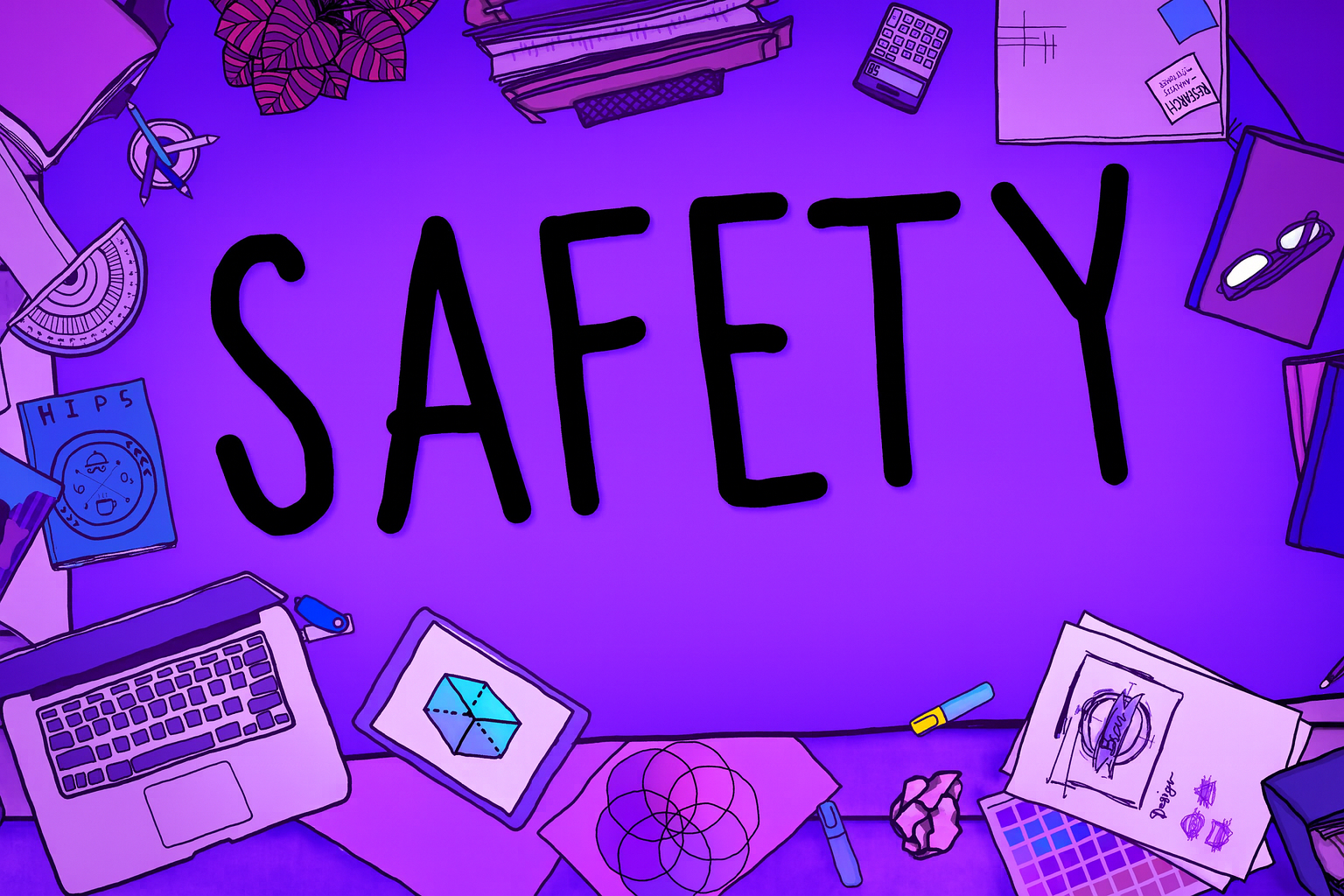I was browsing through the BC government’s K-12 education page, as one is prone to on a Friday at 7:48 a.m. when frustration with the lack of inclusion in the BC education system bubbles up. On the landing page, a section beckons with “Good News in Education,” and it resolves to a 404 page!!! You can’t make this stuff up!
The moment made me laugh aloud, nearing spitting my coffee, because the accident so perfectly captured the province’s relationship to inclusion: a promise that reads brightly in text, but collapses into absence at the point of access.


When “good news” becomes an empty corridor in K-12
Sara Ahmed’s essay The Nonperformativity of Anti-Racism offers offers a lens for reading this moment, because she shows how institutional speech that names a commitment can operate as a substitute for fulfilling it—how a declaration like “we are committed to anti-racism” does not necessarily bring an anti-racist world into being but can instead block the work, absorb dissent, and preserve the institution’s self-image.
The “Good News in Education” link on the K-12 page—offered with cheerful certainty and delivering only a 404—reads in precisely this register: a banner that performs optimism as ceremony while withholding the path to evidence, naming a virtue and leaving the work that would make it real to drift in a corridor of cheerful signage and closed doors, the words standing in for the labour of building a world they merely promise.
What the pages stage, and what they refuse to hold
The flagship K–12 portal frames education as the foundation of a healthy life, then spotlights cell phone restrictions and a shopping campaign alongside a generic invitation to support, and the safe and healthy schools section layers warm assurances about culture and care while deflecting toward seasonal advisories and communicable disease routines, which creates a stage where comfort, neutrality, and consumption sit in the foreground while the material architecture of access waits in the wings for a cue that never arrives.
Who disappears when safety becomes a mood
Disability justice asks whose bodies a promise of safety can carry, so a page that speaks of inclusion, fairness, and equity yet withholds explicit reference to disabled students, to dyslexia, to ADHD, to autism, to intellectual disability, and to the supports each profile requires, performs belonging as ambience while leaving those who live at the edge of exclusion standing at the threshold without a ramp.
A real sense of belonging requires reciprocal recognition, participatory roles, and stable, identity-affirming relationships, as identified in Belonging: A Review of Conceptual Issues, an Integrative Framework, and Directions for Future Research.
Law, duty, and the missing operational detail
A public education ministry carries a legal duty to accommodate disability to the point of undue hardship, which means timelines, roles, escalation paths, and minimum standards for accessible pedagogy, and a portal that aims to guide schools toward safety can carry sections that operationalise this duty with sample accommodation plans, UDL-aligned curriculum supports, assistive technology guidance, and a district-level accountability table that names who approves, who funds, who trains, and who audits.
The behaviour crisis industry and the silences that shield it
Families across the province describe restraint, seclusion, and removal from class as regular dangers, and districts buy crisis intervention programs that shape how staff respond and define what counts as safety. A credible safety page would name these practices, set clear limits, require reporting, share trauma-informed strategies for calming situations, and publish province-wide data broken down by disability, race, gender, and placement, because harm decreases when openness, training, staffing, and oversight work together.
-
Safety plans, billion-dollar scripts, and the harm they keep in place
When a parent hears the words safety plan, there is often a breath held in the chest — a brief hope that the school has recognised the reality of the child’s distress, that they have stepped back to consider what would truly help, that…
Measurement, disclosure, and public accountability in K-12
Safety takes shape through measurement, and measurement creates courage when it moves in public, so a modern portal can present live dashboards for suspensions, removals, use of restraint and seclusion, attendance effects from illness and heat, complaint volumes, resolution timelines, and satisfaction surveys stratified by disability and identity, with open data downloads that allow communities, researchers, and journalists to test claims and track improvement.
Technology, communication, and the right to tools that mediate access
The portal’s emphasis on cell phone restrictions invites a parallel emphasis on disability-related technology, because communication access thrives when policies recognise AAC apps, text-to-speech, executive function supports, and personal safety tools as extensions of the body, so guidance can spell out explicit exemptions, standard documentation processes, and staff training obligations that prevent confiscation or shaming of assistive devices under the banner of classroom order.
Communicable disease, heat, and disability-centred preparedness
The safe schools page leans into communicable disease guidance and heat event preparation, which aligns with climate reality and public health, and disability justice extends this by naming concrete adaptations for students who use mobility devices that trap heat, for students who use medications that affect thermoregulation, for students who communicate through atypical signals, and for students who rely on predictable routines, with checklists, room-by-room cooling plans, sensory-safe refuge spaces, air quality protocols, and family co-planning templates that honour expertise at home.
Food, wellness, and the politics of comfort
A link to a school food toolkit gestures toward care, and a justice lens invites the ministry to pair nutrition resources with commitments that address poverty, disability-related food needs, and the labour that caregivers carry, through guidance on allergy-safe rooms that respect inclusion, flexible eating schedules for students with interoception differences, and funding streams that remove humiliation from access to snacks, breakfast, and hydration supports during heat events.
Complaint, redress, and the ethics of listening
Sara Ahmed describes complaint as feminist pedagogy, a practice that teaches institutions where bodies meet barriers. A safety portal gains integrity when it guides families through clear, humane complaint pathways with templates, timelines, anti-retaliation guarantees, trauma-aware communication standards, and escalation ladders that name independent oversight, with a public annual report that treats patterns as signals for structural repair rather than noise to manage. Also see: When pain gets too close: Affective economies and the emotional cost of advocacy
A disability justice specification for safety pages for K-12
A credible safety architecture for BC schools would go beyond broad statements of care and set out a clear, operational framework. This framework could rest on eleven interlocking pillars, each one tied to the lived realities of students and families:
- Explicit naming of disability communities – list specific groups, such as autistic students, students with ADHD, dyslexia, intellectual disabilities, and complex medical needs, to signal visibility and relevance.
- Operational duty-to-accommodate playbooks – provide step-by-step guides, timelines, templates, and escalation routes so the legal duty to accommodate is actionable and accountable at every level.
- Universal design curriculum supports – offer curriculum resources, lesson adaptations, and assistive technology integration that proactively remove learning barriers.
- Restraint and seclusion limits with reporting – set province-wide rules for when these practices are banned, require incident documentation, and publish disaggregated data.
- Mental health supports framed around connection and sensory regulation – prioritise safety, trust, and emotional regulation over compliance-based behaviour management.
- Technology access policies with AAC exemptions – protect the right to use communication devices, executive function tools, and other assistive tech without fear of confiscation.
- Climate and communicable disease preparedness designed with disabled students and families – plan for heat, air quality, and outbreaks with adaptations for mobility, sensory, and medical needs.
- Transportation, arrival, and transition protocols – reduce stress and energy loss through predictable routines, assistance, and safe, accessible entry points.
- Staffing ratios, training hours, and funding transparency – publish clear targets, investment levels, and professional development commitments.
- Data dashboards with open datasets – provide public, real-time tracking of safety indicators, exclusion rates, and accommodation timelines.
- Co-governance mechanisms – include students, families, and advocates in the committees and decision-making bodies that shape daily practice.
Editorial fixes the ministry can ship this week
The ministry could begin repairing its credibility by acting on a set of straightforward, visible fixes. These changes would signal that the portal is a working tool rather than a hallway of agreeable phrases:
- Replace the broken “Good News” link – create a living page that shares measurable improvements, ties each one to accessible source data, and updates on a regular schedule.
- Add an accessibility and disability section – explicitly name disability communities, outline the duty to accommodate, and provide clear guidance on universal design for learning (UDL).
- Publish a provincewide restraint and seclusion policy – set clear limits, require a standard reporting form, and release quarterly summaries with disaggregated data.
- Issue a cell phone and device policy companion – codify protections for AAC, assistive technology, and other disability-related tools to prevent confiscation or shaming.
- Embed a heat and air quality checklist – include disability-specific adaptations, sensory-safe refuge plans, and printable posters for classrooms.
- Launch a complaints and redress hub – offer templates, timelines, anti-retaliation guarantees, and independent escalation routes so families can pursue resolution without intimidation.
The broken link on K-12 page as an ethics test
The ministry’s pages are saturated with the language of care, safety, and inclusion, yet the texture of these words is thin, their edges polished for display rather than grip.
Each appearance of “inclusive,” “equity,” or “positive” reads less like a commitment and more like marketing blanketing a system that still routes disabled students and their families around the back, if it routes them anywhere at all.
A 404 on a promise of good news is a mirror, because infrastructure shows the truth of culture with a clarity that prose cannot disguise.
When the ministry repairs the link and fills it with verifiable, accessible, disability-centred progress, it signals a shift from performance to practice, from soothing language to shared safety, from signage to doors and ramps that work.
Update Oct 28, 2025: It’s still broken. No good news ever?
-
Engineered famine in public education
In British Columbia schools today, we are not facing a behaviour crisis—we are facing a famine of care. This essay weaves together personal memory, systemic critique, and deep empathy for teachers and families alike to ask why our schools are starving the very…









